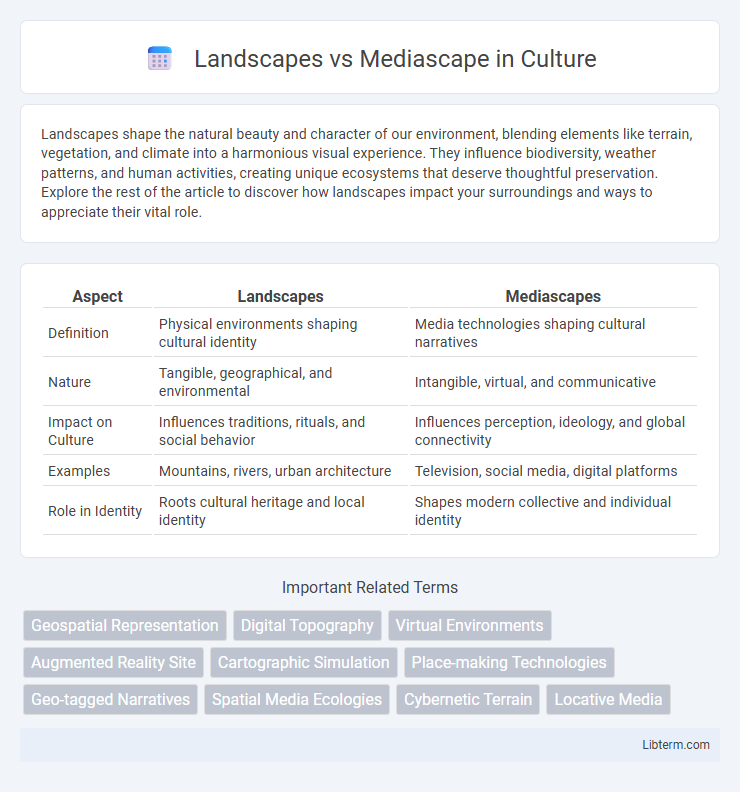Landscapes shape the natural beauty and character of our environment, blending elements like terrain, vegetation, and climate into a harmonious visual experience. They influence biodiversity, weather patterns, and human activities, creating unique ecosystems that deserve thoughtful preservation. Explore the rest of the article to discover how landscapes impact your surroundings and ways to appreciate their vital role.
Table of Comparison
| Aspect | Landscapes | Mediascapes |
|---|---|---|
| Definition | Physical environments shaping cultural identity | Media technologies shaping cultural narratives |
| Nature | Tangible, geographical, and environmental | Intangible, virtual, and communicative |
| Impact on Culture | Influences traditions, rituals, and social behavior | Influences perception, ideology, and global connectivity |
| Examples | Mountains, rivers, urban architecture | Television, social media, digital platforms |
| Role in Identity | Roots cultural heritage and local identity | Shapes modern collective and individual identity |
Understanding Landscapes: Definition and Types
Landscapes refer to the visible features of an area of land, including physical elements like mountains, rivers, and vegetation, as well as human-made structures, shaping the overall environment. Types of landscapes include natural landscapes such as forests and deserts, cultural landscapes influenced by human activity, and urban landscapes dominated by cities and infrastructure. Understanding landscapes involves analyzing their composition, ecological significance, and the ways human interaction modifies or preserves these environments.
Mediascapes Explained: Concepts and Origins
Mediascapes refer to the complex and dynamic distribution of electronic capabilities that allow individuals to create, access, and share media content across the globe, shaping cultural and social narratives. Originating from Arjun Appadurai's theory of global cultural flows, mediascapes encompass a wide array of media forms, including films, television, newspapers, and digital platforms, which influence how societies perceive and interact with the world. These media-driven landscapes contribute to the construction of imagined realities, where audiences interpret and negotiate identity, power, and information within a rapidly evolving global context.
Physical vs Digital: Key Differences
Landscapes represent physical environments shaped by natural and human elements, while mediascapes encompass the digital and virtual spaces created through media technologies. Physical landscapes consist of tangible features such as mountains, rivers, and urban structures, whereas digital mediascapes include online platforms, social media networks, and virtual realities. The key difference lies in the sensory experience and accessibility; landscapes offer direct physical interaction, while mediascapes provide mediated, often global, connectivity through digital interfaces.
The Evolution from Landscapes to Mediascapes
The evolution from landscapes to mediascapes marks a shift from static, physical environments to dynamic, media-driven contexts shaped by digital technology and global communication networks. Landscapes represent tangible, geographic spaces defined by natural and cultural features, whereas mediascapes encompass fluid, virtual spaces constructed through images, narratives, and information flows disseminated via electronic media. This transition underscores how contemporary experiences and identities are increasingly mediated by interactive multimedia platforms, creating hybrid realities that blend physical presence with digital representation.
Cultural Influences on Perceptions of Space
Landscapes shape cultural identities by embedding historical, social, and environmental meanings into physical spaces, influencing how communities perceive and interact with their surroundings. Mediascapes, as representations of space through media and digital technologies, construct virtual environments that affect cultural perceptions by circulating images and narratives globally. The interplay between landscapes and mediascapes highlights how traditional spatial experiences and mediated representations together redefine cultural understandings of place and identity.
The Role of Technology in Shaping Mediascapes
Technology drives the evolution of mediascapes by enabling dynamic content creation, distribution, and interaction across digital platforms, transforming passive landscapes into interactive realities. High-speed internet, mobile devices, and social media algorithms shape personalized media experiences, influencing cultural perceptions and information flows globally. Advanced technologies like augmented reality and artificial intelligence further blur boundaries between physical landscapes and digital mediascapes, creating hybrid environments that redefine social and spatial interactions.
Landscape Representation in Media
Landscape representation in media shapes cultural perceptions by highlighting natural and human-modified environments through visual storytelling, cinematography, and digital art. Media often emphasizes iconic landscapes to convey identity, emotion, and narrative context, influencing audience engagement and environmental awareness. The mediation of landscapes involves selective framing and symbolic meanings that reflect sociopolitical values and ecological concerns.
Impacts on Society and Identity
Landscapes shape societal identity by embedding cultural values and historical narratives into physical environments, influencing community cohesion and a sense of belonging. Mediascapes, through dynamic and global flows of images and information, impact individual and collective identities by constantly reshaping perceptions and social realities. Both landscapes and mediascapes interact to construct complex frameworks of social meaning, affecting how groups define themselves and relate to others in a rapidly changing world.
Case Studies: Landscapes and Mediascapes Intersect
Case studies on landscapes and mediascapes reveal the dynamic interaction between physical environments and digital representations, illustrating how cultural narratives are shaped and reshaped through media technologies. Urban landscapes documented through social media platforms transform local spaces into global mediascapes, reflecting hybrid identities and contested meanings. These intersections demonstrate the evolving role of media in constructing place-based experiences and the socio-political implications of mediated landscapes.
Future Trends: Convergence of Nature and Media
Future trends reveal a growing convergence of landscapes and mediascapes through augmented reality (AR) and virtual reality (VR) technologies, blending natural environments with digital experiences. Smart cities incorporate interactive media layers into physical spaces, fostering immersive, context-aware interactions that redefine public and private landscapes. This fusion enhances environmental awareness and cultural engagement, transforming traditional media consumption into dynamic, spatially integrated narratives.
Landscapes Infographic

 libterm.com
libterm.com